- The Design Mode uses the original component
documents.
In other words, geometry is selectable and workbench commands are available if this mode is activated. - The Visualization Mode uses documents in cgr format.
Only the external appearance of the component is visualized and the geometry is not selectable, which may be useful when you deal with sophisticated assemblies with large amounts of data but only need a few components to work on. Using a cache system considerably reduces the time required to load your data.
- Make sure that the Work with the cache system option is
selected (by default, the cache is not activated).
See Cache Management for CATProduct and CATProcess Document. - Make sure that the Automatic switch to Design mode option
is selected.
See General settings. - Make sure that the Compute exact update status at open
option is manual.
See General settings.
-
Open the AssemblyConstraint07.CATProduct document.
-
When opening assembly documents in Visualization Mode, the Status Unknown icon
 is always active, because the application cannot identify whether the
assembly is up-to-date or not.
is always active, because the application cannot identify whether the
assembly is up-to-date or not. -
Looking closer at the specification tree, you can notice that the nodes are expandable, components are displayed with the following format: Instance_Name [Document_Name]
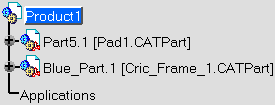
-
Click the + symbol of each component nodes.
Looking closer at the specification tree, you can notice that the nodes are not expandable, components are displayed with the following format: Product_Name (Instance_Name).
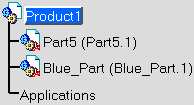
-
The assembly has performed the update status: the Update icon
 is grayed, the assembly is up to date.
is grayed, the assembly is up to date. -
Information contained in the CATPart document about annotation, publication or contextual part for example, can be loaded, but not the affected geometry. An information is then displayed on the object icon in the specification tree indicating that the geometry is not loaded or eventually broken (i.e. an exclamation mark mask on each published element, a question mark mask on each annotation, etc).
Note that for this sample nothing has been loaded.
According to the selected options:
-
As you are moving your cursor onto any geometrical element of the parts in Visualization Mode, you can notice that an eye symbol is located next to your arrow.
This indicates that the geometrical element can be constrained, but take into account once it is selected. -
Select a geometrical element or a published geometrical element loads almost the entire CATPart document in session, furthermore for publication of Generative Shape Design objects like point, line or plane, you have to complete yourself the entire loading of the CATPart document before select the published element (i.e. by clicking the + symbol on the part node).
When setting the constraint on the Part.5, the CATPart document is loaded and appears under the related component.
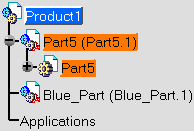
Then on the Blue_Part, the CATPart document is loaded and appears under the related component.
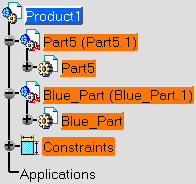
Once the constraint is set, take a look at the tree.
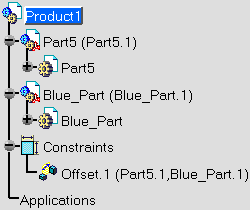
-
The fact that the application resolves constraints while working in Visualization Mode is possible only if your document contains data created from Release 10, and not using previous releases.
-
The application resolves constraints set from published elements from Release 11.
-
Contextual parts in Visualization Mode remain in this mode if they are up-to-date, on contextual publication all version, on contextual geometry from Release 11.
-
When CATPart are modified and saved outside of the CATProduct context,
or when CATPart are partially loaded, modified, saved and unloaded in the CATProduct context,
the constraints cannot be updated in Visualization Mode anymore.
You need to load CATPart in Design Mode in the CATProduct context and force the CATProduct save.
Setting the Design or Visualization Mode
When you open a product document in Visualization Mode, you can define a mode specific to a component using the following contextual commands: Representations > Visualization Mode or Representations > Design Mode.